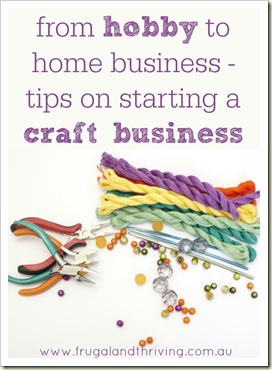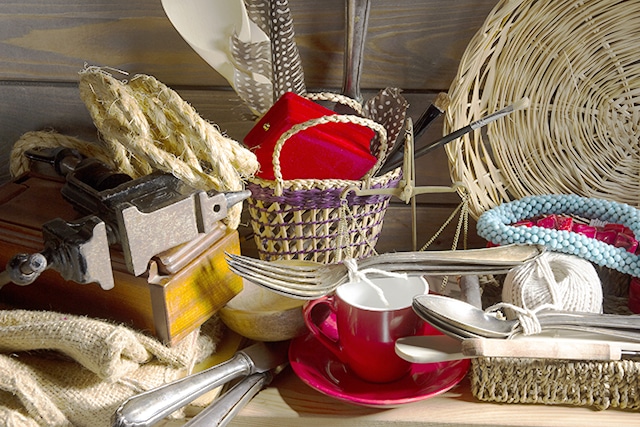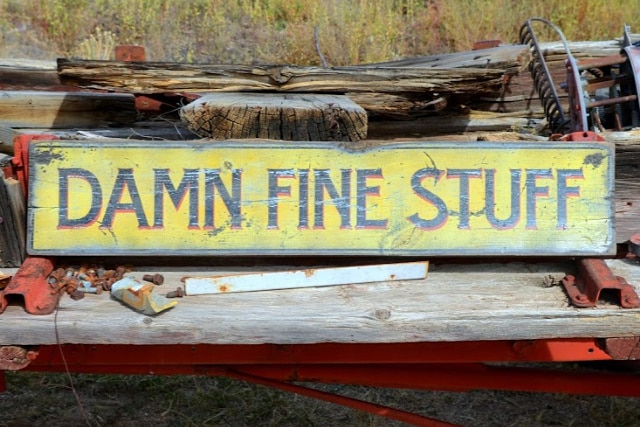from hobby to home business – things to consider when starting a home craft biz
This website may earn commissions from purchases made through links in this post.

Or are you hoping to give up your day job so that you can spend your time doing what you love and getting paid for it?
Turning your hobby into a home based business can be a great way to do just that.
But before you start selling your handmade creations, there are a few things you need to consider.
Increase your chance of running a successful craft business by doing a little planning and research before you get started.
This article outlines some of the things you need to consider before you start your home craft business.
WHAT PRODUCTS ARE YOU GOING TO SELL?
To start a craft business, you first have to have a product or products you which you can make and sell.
- What product(s) can you make?
- Are you able to produce them at a high quality?
- Will you craft easily reproducible items or craft unique, one-off pieces?
- Can you produce several related products that match? Or several styles, colours and sizes etc.?
- What can you make that is different to, unique or better than what is already being on the market? Can you improve on appearance, performance or marketability of what is already out there?
- Does your product fit a theme? This will help you market your product.
WHEN CRAFTING IS NO LONGER A HOBBY
There are two approaches you can take to a craft business: a casual, sell as you craft approach, or a more business oriented approach.
The first approach is a good way to make a bit of pocket money and cover the cost of your crafting supplies.
But if you want to make enough profits to pay the bills, you will need to turn your hobby into a business, which takes planning and discipline.
There’s a big difference between crafting for pleasure and crafting for profit.
It’s important to remember that what was once enjoyable and relaxing can become a chore when you’re have to meet quotas and deadlines.
To maximise your time, you will want to work out some kind or assembly line so you can produce as many products in the least amount of time. This can increase your productivity and your profit, but it can also takes a lot of the joy out of a craft you once did for fun.
So before you start, you need to ask yourself whether you’re prepared for your hobby to become your job?
What will you do to unwind when your hobby becomes your work?
IS THERE A MARKET FOR WHAT YOU MAKE?
This is one of the most important question you need to ask: are there people wanting to buy what you can make for the price you’re asking?
It’s a lot easier to sell things people already want to buy rather than trying to convince people they want what you have to sell.
A great craft business is the intersection of what you can produce with what people want to buy.
So before you even start show friends and family what you have and ask:
- would they be willing to buy it?
- what would they pay for it?
- where would they expect to buy this?
The next thing to do is have a look around at markets or online at places like Etsy to see if what you’re selling is already out there? If there are similar products, then that’s a good indication there is already a market for what you want to make, which is a good thing.
Once you’ve established there’s a market for your product the next question to ask is how are you going to stand out from the crowd?
What makes your product different from your competition? What need or want are you filling that isn’t already being filled?
The other important question to ask yourself is whether you’re trying to compete with items that are mass-produced. Can people buy something similar for a fraction of the price from a big-box store?
Competing on price with mass-produced goods is very difficult. Instead, offer something unique, that can’t be bought in a regular store.
WHO IS YOUR MARKET?
Who will buy your product?
It’s important to define exactly who will buy your product and keep your ideal customer in mind because it will help you craft your product to meet their needs and it will help you reach them in your marketing efforts.
Create a persona of your ideal customer. Male or female? Age? Kids? Demographics? Interests? Hobbies? Likes and Dislikes? Needs and Wants?
For more information on defining your market see: How to find your target market or their updated version: Save Time and Money. Find Your Target Market.
THE PRACTICALITIES: WHERE, WHEN, HOW?
Where will you craft? Do you have room at home?
When will you craft? Do you have to work around an existing job? Childcare?
Where will you store your supplies and finished products?
Are there legal or licencing requirements that you need to meet (in the case of food or personal care items)?
Do you need to register a business name? File for an ABN?
How will you fund your craft business? How will you pay for supplies?
You’re going to need somewhere at home to craft your products as well as store your supplies.
You will also need to work out when you will be crafting.
Some friends of mine, both mums with small children, have recently started a home craft business making and selling vintage-inspired home wares.
“because we have the kids, we do ‘craft days’ where we meet at one of our houses and do craft as the kids play together.”
SUPPLIES
Buying craft supplies retail is going to seriously eat into your profits, so it pays to spend time sourcing wholesale suppliers.
Before you source wholesale suppliers, you will need an an Australian Business Number (ABN) as many wholesalers will only supply to a business. You can apply for an ABN online.
Find wholesale suppliers by searching Google, looking in trade magazines, going to trade shows, searching eBay and Facebook and asking other crafters in your niche.
The quality of your final product will depend on the quality of your raw materials, so it’s important to source quality supplies at an affordable price.
Because my friends from Olive and Ma craft vintage inspired crafts, a lot of their supplies have come from markets and second hand stores as well as friends and family.
“Ask around to family and friends for craft materials they no longer want; we got lots of supplies from family, craft goods they had just sitting around and not using.”
SELLING YOUR PRODUCTS – CHOOSING AN OUTLET
Selling your products can be as simple as setting up a Facebook page and promoting your page. Facebook offers a free sales platform – simply upload photos of your product and ask potential buyers to comment ‘sold’ on the photo.
See: Facebook selling case study
Other online sales avenues include eBay, Etsy and Made It as well as through your own website using an online shopping cart.
It’s a good idea to have a website no matter what avenue you sell through as this will help build your brand and market your products (see marketing below for more info).
Offline avenues for selling include local markets, bricks and mortar store or through existing retail stores, either selling your products at wholesale prices to stores or selling your crafts on consignment.
Further reading:
- How to sell on Etsy
- Everything you need to know about selling on Etsy
- Wholesale, retail and beginning to sell your handmades to shops
- Selling wholesale and retail
- How to sell your craft to stores
- Craft market selling 101: A beginner’s guide
- Guide to selling at a craft fair
- Online craft sales – Your own site or a third party site?
- What to consider when creating a website
PRICING FOR PROFIT
It’s easy to underestimate the skill that has gone into the process of making what you do and then under price your products.
But if you are trying to make a living, you need to price your product accordingly.
There are two methods you can use to price your products: you can price them according to cost: the cost of materials, labour, packaging, postage, administration + a profit margin.
You can also price according to the market – what are your competitors selling for? What price will your buyers pay?
It’s important to use market prices as a guideline not to undercut your competitors and therefore your own profit margin. Distinguish your craft business through quality or uniqueness rather than price.
Don’t forget that you want to have a wholesale price and a retail price, especially if you sell to other stores. Price your retail price similar to what the price would be in store (around double) so as not to undercut the stores you sell to.
Further reading:
- How do I price my handmade goods?
- How to price your handcrafted goods
- Etsy Shop Help – Pricing Your Goods
MARKETING YOUR CRAFT BUSINESS
What is marketing?
Marketing is selling.
Marketing lets people know about your business and your products. It helps them to decide whether what you are selling is right for them.
How you market your business will depend on who your market is (see above). If your market is local, then local marketing avenues makes sense. You might advertise through local publications, for instance.
“We donated one of the dream catchers to be used in a local fundraising auction to draw attention to our products.” [Olive and Ma]
If your market is online, where do your potential customers hang out? Are they on Facebook? Then you need to promote yourself via a Facebook page? Do they like Pinterest? Start a Pinterest account.
Regardless of whether you sell online or off (or both) it’s a good idea to have a website. In the very least, it’s a good idea to own the domain name for your business name in case you want to build a website in the future. A domain name only costs around $10 a year.
A webpage strengthens your brand and gives potential customers more details about you. And with a shopping cart, it can also be another storefront.
When marketing your business, it’s important to establish consistent branding that you use in signage, business cards, on your website, Facebook page, Pinterest account, Etsy store or where ever else you are selling. A professionally designed logo doesn’t cost the earth but will give your craft business a professional edge. Use your logo across all your marketing avenues.
And don’t forget to promote your website and social media accounts in your offline marketing like business cards and flyers.
Further reading:
- How to get started with marketing my crafts on a limited budget
- Ways to market your craft business cheaply/freely
- Craft business Pinterest tips
- Tips on setting up a website for a craft business
- 10 things you must do to have a successful online craft business
- Grow your handmade business through your blog
- How to use a blog to grow your business
- Top tips to selling your crafts online
- Make social media work for you: how to promote your crafty business online
- A graphic designer’s guide to creating a brand strategy for your craft business
- Branding your craft business
TAKE GREAT PHOTOS
If you’re selling your crafts online, it’s essential that you take great photos of your products. Your photo alone will sell your product.
Take photos of your products from several angles in natural light. Use a fairly plain background that’s not distracting.
Check out Etsy listings of products similar to yours for ideas on how to style you product, but don’t forget to infuse your own style that reflects your brand and keeps your ideal customer in mind.
Further reading:
- Sell more now – 5 tips for taking great product photos
- Indoor product photography tips
- Etsy shop photography advice for new shop owners
- How to use a light tent for small product photography
- The simple guide to taking awesome product photos
RECORD KEEPING
Record keeping and tax is usually the last task that gets done in a home based business. Make it easy by keeping good records and update them regularly.
Start off on the right foot and plan to keep good records by being organised. How are you going to keep track of expenses and income? Spreadsheet? Account book?
Are you going to use a separate bank account?
Do you need to register a business name? Have you applied for an ABN?
Have a system for filing receipts and backing up data on your computer.
You’re goal is to make a profit, and the only way to tell if you are is to keep proper records of your income and expenses.
BUSINESS PLANNING
If you’re thinking that creating a business plan is going to be a tedious task, then you’ll be glad to hear that if you have worked through the above points, you will already have a fairly detailed plan!
- What are your business goals?
- Who is your market?
- What products will you sell? What makes them unique (list benefits and features)?
- What is your marketing strategy? In other words, how will your target customers find you?
- How will you finance your business. Outline budgeted income and costs.
Further reading:
KEEPING SKILLS AND KNOWLEDGE UP TO DATE
It’s important to keep up-to-date with the latest trends, fashions, tools and supplies in your niche.
You can do this by attending craft and trade shows, subscribing to trade magazines and following blogs, Facebook pages and Pinterest boards in your niche.
A home-based craft business can be a fulfilling way to earn a living and it’s a great way to work from home, doing the things that you love.
Improve your success (and your profit margins) by spending a little time planning your craft business and the marketing of your product.






How can a hobby stay a hobby? I love sewing and I’d like to be able to sell bags and wallets off and on. I don’t want anything that would class as a business just pocket money. My plan is to donate some of the money i make to a particular charity and thd rest to go back into my supllies. I’m a mother of 2 a d my husband works to pay our bills etc.
Will a craft supply store for children’s craft activities need public liability insurance?
You should check with your local business advisory network.
Wanting to start selling my macrame tee pees I have been making ….I don’t think they are suitable for child play due to the ropes … I want to sell them as photo props …your advise would be appreciated….what things legally do I need to do …thanks in advance June
It is best to ask your local business council for local regulations.
What an amazing resource! Thank you :)